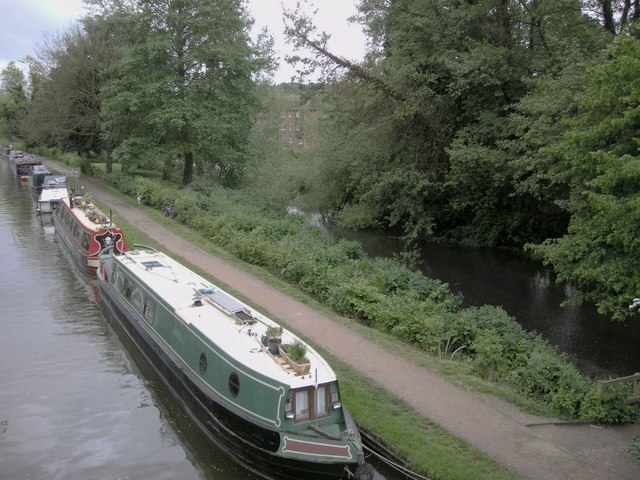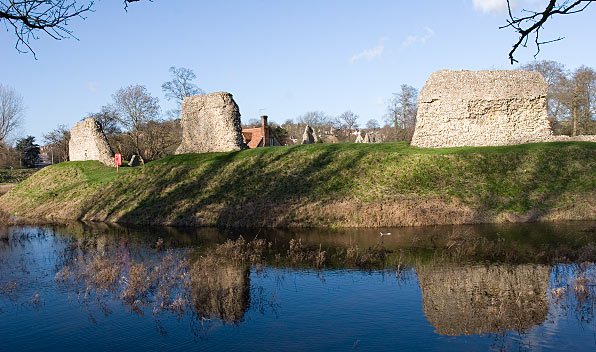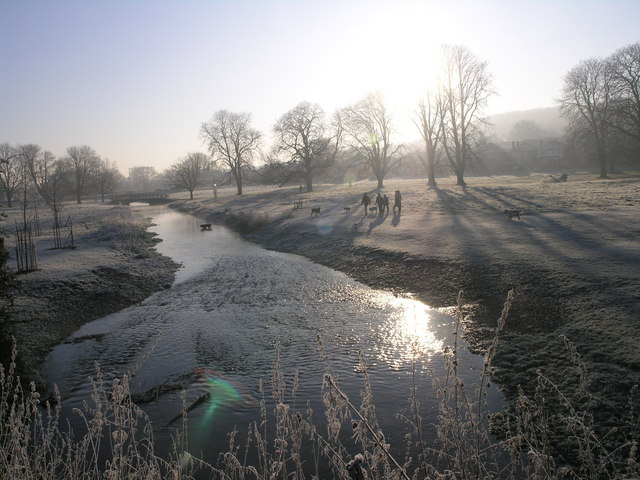Bulbourne on:
[Wikipedia]
[Google]
[Amazon]
The River Bulbourne is a small river in
 The River Bulbourne was historically rich in eels and other fish, fast-moving and prone to frequent localised flooding. Over the years, human activity has had a significant effect on the river. Originally, the source of the Bulbourne was near the hamlet of Bulbourne, near
The River Bulbourne was historically rich in eels and other fish, fast-moving and prone to frequent localised flooding. Over the years, human activity has had a significant effect on the river. Originally, the source of the Bulbourne was near the hamlet of Bulbourne, near  Early Anglo-Saxon settlements arose in Northchurch and Berkhamsted. In the
Early Anglo-Saxon settlements arose in Northchurch and Berkhamsted. In the
 The Bulbourne flows through
The Bulbourne flows through
River Bulbourne interactive map
on the Chilterns AONB website {{DEFAULTSORT:Bulbourne Rivers of Hertfordshire Dacorum Colne catchment, 2Bulbourne
Dacorum
The Borough of Dacorum is a local government district in Hertfordshire, England that includes the towns of Hemel Hempstead, Berkhamsted, Tring and Kings Langley. The district, which was formed in 1974, had a population of 137,799 in 2001. I ...
, Hertfordshire, England
England is a country that is part of the United Kingdom. It shares land borders with Wales to its west and Scotland to its north. The Irish Sea lies northwest and the Celtic Sea to the southwest. It is separated from continental Europe b ...
. The word bourne derives from the Anglo-Saxon word for a stream. It is an unnavigable tributary
A tributary, or affluent, is a stream or river that flows into a larger stream or main stem (or parent) river or a lake. A tributary does not flow directly into a sea or ocean. Tributaries and the main stem river drain the surrounding drai ...
of the River Gade
The River Gade is a river running almost entirely through Hertfordshire. It rises from a spring in the chalk of the Chiltern Hills at Dagnall, Buckinghamshire and flows through Hemel Hempstead, Kings Langley, then along the west side of Watfo ...
, which flows into the River Colne, which in turn is a tributary of the River Thames
The River Thames ( ), known alternatively in parts as the River Isis, is a river that flows through southern England including London. At , it is the longest river entirely in England and the second-longest in the United Kingdom, after the R ...
. The Bulbourne is an example of a chalk stream
Chalk streams are rivers that rise from springs in landscapes with chalk bedrock. Since chalk is permeable, water percolates easily through the ground to the water table and chalk streams therefore receive little surface runoff. As a result, th ...
, which is a watercourse that flows from chalk-fed groundwater. Chalk streams are a very rare habitat globally, with more than 85% of all the 210 chalk streams in the world are found in England. The river is reduced in size, due to human activity, the main one being the building of the London to Birmingham Grand Union Canal through the narrow valley which takes most of the river's water.
Geography
The Bulbourne flows in the Chiltern Hills, part of a system ofchalk downland
Downland, chalkland, chalk downs or just downs are areas of open chalk hills, such as the North Downs. This term is used to describe the characteristic landscape in southern England where chalk is exposed at the surface. The name "downs" is deriv ...
s throughout eastern and southern England, which formed between 84 and 100 million years ago in the Cretaceous Period
The Cretaceous ( ) is a geological period that lasted from about 145 to 66 million years ago (Mya). It is the third and final period of the Mesozoic Era, as well as the longest. At around 79 million years, it is the longest geological period of t ...
when the area was a chalk
Chalk is a soft, white, porous, sedimentary carbonate rock. It is a form of limestone composed of the mineral calcite and originally formed deep under the sea by the compression of microscopic plankton that had settled to the sea floor. Ch ...
-depositing marine environment. The valley is at the southernmost limit of the Pleistocene glaciation
The Quaternary glaciation, also known as the Pleistocene glaciation, is an alternating series of glacial and interglacial periods during the Quaternary period that began 2.58 Ma (million years ago) and is ongoing. Although geologists describe ...
ice erosion of the Chiltern scarp, giving it a smooth, rounded appearance. Around Berkhamsted the valley sides rise 300 ft. It is situated on the northern rim of the larger syncline or down-folding of rocks called the London Basin
The London Basin is an elongated, roughly triangular sedimentary basin approximately long which underlies London and a large area of south east England, south eastern East Anglia and the adjacent North Sea. The basin formed as a result of compre ...
. The underlying geology is chalk, which outcrops in places along the east side of the valley. The subsoil is predominantly a stiff reddish clay-with-flints; in the valley itself the chalk is overlain with alluvium
Alluvium (from Latin ''alluvius'', from ''alluere'' 'to wash against') is loose clay, silt, sand, or gravel that has been deposited by running water in a stream bed, on a floodplain, in an alluvial fan or beach, or in similar settings. ...
.
Course
The river runs in a south-easterly direction from between Cow Roast and Dudswell inNorthchurch
Northchurch is a village and civil parish in the Bulbourne valley in the county of Hertfordshire in the United Kingdom. It lies between the towns of Berkhamsted and Tring.
Situated on the Roman road Akeman Street, a major Roman villa dating fr ...
, through Berkhamsted
Berkhamsted ( ) is a historic market town in Hertfordshire, England, in the Bulbourne valley, north-west of London. The town is a civil parish with a town council within the borough of Dacorum which is based in the neighbouring large new town ...
, Bourne End and Boxmoor
Boxmoor is part of Hemel Hempstead in Hertfordshire. It is within the district of Dacorum and comprises mainly 19th-century housing and meadowland, with transport links from London to the Midlands. At the 2011 Census, the population of Boxmoor wa ...
, to where it joins the River Gade
The River Gade is a river running almost entirely through Hertfordshire. It rises from a spring in the chalk of the Chiltern Hills at Dagnall, Buckinghamshire and flows through Hemel Hempstead, Kings Langley, then along the west side of Watfo ...
at Two Waters in Apsley near Hemel Hempstead
Hemel Hempstead () is a town in the Dacorum district in Hertfordshire, England, northwest of London, which is part of the Greater London Urban Area. The population at the 2011 census was 97,500.
Developed after the Second World War as a new ...
. The current total length of the river is ; from its source to its mouth it falls .
Human activity
 The River Bulbourne was historically rich in eels and other fish, fast-moving and prone to frequent localised flooding. Over the years, human activity has had a significant effect on the river. Originally, the source of the Bulbourne was near the hamlet of Bulbourne, near
The River Bulbourne was historically rich in eels and other fish, fast-moving and prone to frequent localised flooding. Over the years, human activity has had a significant effect on the river. Originally, the source of the Bulbourne was near the hamlet of Bulbourne, near Tring
Tring is a market town and civil parish in the Borough of Dacorum, Hertfordshire, England. It is situated in a gap passing through the Chiltern Hills, classed as an Area of Outstanding Natural Beauty, from Central London. Tring is linked to ...
(which would make the river longer); in 1700 the source was said to be Parkhill Farm, near Pendley Manor
Pendley Manor is a hotel, conference and function centre near Tring, Hertfordshire, UK. It is a historic country house and is Listed building, Grade II listed as an important example of Victorian architecture.
History
A village of Pendley (or '' ...
(making the river shorter).
Settlement in the valley began prior to the Late Iron Age
The Iron Age is the final epoch of the three-age division of the prehistory and protohistory of humanity. It was preceded by the Stone Age (Paleolithic, Mesolithic, Neolithic) and the Bronze Age (Chalcolithic). The concept has been mostly appl ...
period. The upper Bulbourne Valley was rich in timber and iron ore. In the late Iron Age, a area around Northchurch
Northchurch is a village and civil parish in the Bulbourne valley in the county of Hertfordshire in the United Kingdom. It lies between the towns of Berkhamsted and Tring.
Situated on the Roman road Akeman Street, a major Roman villa dating fr ...
was a major iron production centre (considered to be one of the most important late Iron Age and Roman industrial areas in England). Water was drawn from 14 well shafts close to the river at Cow Roast, where a Roman town grew up between the river and the Roman- engineered Akeman Street
Akeman Street is a Roman road in southern England between the modern counties of Hertfordshire and Gloucestershire. It is approximately long and runs roughly east–west.
Akeman Street linked Watling Street just north of Verulamium (near mode ...
(which had been a pre-existing route from St Albans (''Verulamium'') to Cirencester
Cirencester (, ; see below for more variations) is a market town in Gloucestershire, England, west of London. Cirencester lies on the River Churn, a tributary of the River Thames, and is the largest town in the Cotswolds. It is the home of ...
(''Corinium'')) Iron production ceased at the end of the Roman period. There were Roman villas in Northchurch, Berkhamsted and Boxmoor
Boxmoor is part of Hemel Hempstead in Hertfordshire. It is within the district of Dacorum and comprises mainly 19th-century housing and meadowland, with transport links from London to the Midlands. At the 2011 Census, the population of Boxmoor wa ...
. Early Anglo-Saxon settlements arose in Northchurch and Berkhamsted. In the
Early Anglo-Saxon settlements arose in Northchurch and Berkhamsted. In the Medieval period
In the history of Europe, the Middle Ages or medieval period lasted approximately from the late 5th to the late 15th centuries, similar to the post-classical period of global history. It began with the fall of the Western Roman Empire a ...
, the Bulbourne powered two watermill
A watermill or water mill is a mill that uses hydropower. It is a structure that uses a water wheel or water turbine to drive a mechanical process such as milling (grinding), rolling, or hammering. Such processes are needed in the production of ...
s in Berkhamsted (Upper and Lower - recorded in 1086) and another in Bourne End. It also fed the three moats of the large Norman
Norman or Normans may refer to:
Ethnic and cultural identity
* The Normans, a people partly descended from Norse Vikings who settled in the territory of Normandy in France in the 10th and 11th centuries
** People or things connected with the Norm ...
( Motte and Bailey) Berkhamsted Castle
Berkhamsted Castle is a Norman motte-and-bailey castle in Berkhamsted, Hertfordshire. The castle was built to obtain control of a key route between London and the Midlands during the Norman conquest of England in the 11th century. Robert of ...
, that stands close to the centre of the town. The river created a marsh environment (at times referred to as an 'unhealthy swamp') in the centre of the valley, which added to the defences of the castle.
During the Industrial Age in 1797, the Grand Union Canal
The Grand Union Canal in England is part of the British canal system. It is the principal navigable waterway between London and the Midlands. Starting in London, one arm runs to Leicester and another ends in Birmingham, with the latter ...
was dug alongside the entire length of the river, and the Bulbourne became the main source of water for the canal, which was the main link between London and the coalfields of the Midlands. This manmade waterway was the only one to be built across the Chilterns Hills. Ensuring a constant supply of water in a region of permeable chalk was an engineering challenge which required the building of reservoirs, pumps and boreholes.
After the Pre-Roman Road and the canal, the third major transport route to carve its way along the Bulbourne valley was the London to Birmingham railway, in 1834.
In 1883, the ''Berkhamsted Times'' congratulated a Mr Bedford on having converted the remaining "dirty ditches and offensive marshes" into watercress
Watercress or yellowcress (''Nasturtium officinale'') is a species of aquatic flowering plant in the cabbage family Brassicaceae.
Watercress is a rapidly growing perennial plant native to Europe and Asia. It is one of the oldest known leaf v ...
beds. Thus the River Bulbourne was reduced by centuries of increased drinking needs, dredging, milling and agriculture, as well as by the London to Birmingham
Birmingham ( ) is a City status in the United Kingdom, city and metropolitan borough in the metropolitan county of West Midlands (county), West Midlands in England. It is the second-largest city in the United Kingdom with a population of 1. ...
Canal.
In October 2011, concerns were raised about local water levels when the River Bulbourne dried up. Local commentators blamed increased water consumption brought about by the number of new property developments in Berkhamsted, although the Environment Agency and the Veolia
Veolia Environnement S.A., branded as Veolia, is a French transnational company with activities in three main service and utility areas traditionally managed by public authorities – water management, waste management and energy services. It pr ...
water company claimed it was due to a low water table, caused by lack of rainfall.
Tributaries
The Bourne Gutter is a short tributary of the Bulbourne, rising between Berkhamsted and Bourne End. In very wet years it runs from springs nearly three miles further up a side valley, near Hockeridge Bottom. According to local legend it is a "Woe Water", said to only flow at a time of national emergency. Another small tributary was at St Johns Well Lane (in Berkhamsted); it dried up in the 1930s due to increased local water-pumping needs. From at least the Middle Ages the 'holy well' there had been Berkhamsted's principal source of drinking water.Part restoration
 The Bulbourne flows through
The Bulbourne flows through Boxmoor
Boxmoor is part of Hemel Hempstead in Hertfordshire. It is within the district of Dacorum and comprises mainly 19th-century housing and meadowland, with transport links from London to the Midlands. At the 2011 Census, the population of Boxmoor wa ...
, and it was on this stretch that a major river restoration project was undertaken in January 2017. Working in conjunction with the Environment Agency, the Box Moor Trust restored a kilometre stretch of the River; the river in this location had been heavily modified in the past, and as a result was overly deep, straight and wide. As such, the restoration work was carried out in order to return the river to a more natural state. The bulk of this work was carried out in January 2017, whilst the creation of Vernal pool, ephemeral ponds took place in November, 2017. The ‘Bringing Back the Bulbourne’ project scooped the ‘best medium scale’ award at The Wild Trout Trust Conservation Awards. The natural meander of this section of the chalk stream was restored (a globally rare habitat), creating new habitats for plants and wildlife. Removing a weir has allowed fish to move along the river, while cutting back trees has allowed more light to reach the river.
References
Sources
* * *External links
River Bulbourne interactive map
on the Chilterns AONB website {{DEFAULTSORT:Bulbourne Rivers of Hertfordshire Dacorum Colne catchment, 2Bulbourne